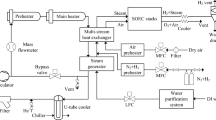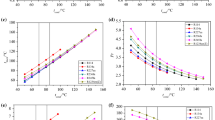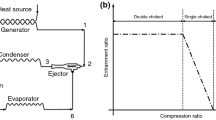Abstract
Steam jet large-temperature-drop heat exchange system (SJHE) is presented to improve the heat exchange effect between exothermic and endothermic media in the heat exchange process. In this paper, with the higher efficient CRMC ejector, the mathematical model of the SJHE system is constructed. We compared the application scopes of two system constructions with 10 different working fluids and select the more feasible system construction as the optimal system. Based on the real properties of 10 environment-friendly dry pure fluid, R141b is screened as the best cycle working fluid for the system, using which the exothermic medium can be reduced to 33.7 °C in the district heating situation (primary water supply temperature: 130 °C, and the temperature lift range of secondary water is 45–60 °C). Moreover, the thermodynamic characteristics of the SJHE system are evaluated to achieve a better understanding of the thermal performance of this new heat exchanger system.
Access provided by Autonomous University of Puebla. Download conference paper PDF
Similar content being viewed by others
Keywords
- Large-temperature-drop heat exchange system
- System construction comparison
- Working fluid selection
- Thermodynamic evaluation
1 Introduction
For the purpose to control the air/water pollution and ensure environmental safety, as the thermal power and the nuclear plants are always set far away from the urban areas. It results in a large scale of heating networks [1]. Therefore, the long-distance heating supply technology has been applied. However, several problems are still existing [2]. One of them is the ineffectiveness due to the high thermal loss and pump work consumption during the heat media transportation [3]. To address this issue, solutions are presented. The large-temperature-drop heat supply technology is a meaningful and effective way to reduce the thermal dissipation and pump power in the heat transmission process [4]. Easily note that \(T_{{{\text{pri}},{\text{in}}}} > T_{{\sec ,{\text{out}}}}\) and \(T_{\text{pri,out}} > T_{\text{sec,in}}\), which would cause system failure in the heat substation with normal heat exchangers according to the second law of thermodynamics.
Attempts are conducted to extend the heat exchange capacity in the heat network substation. The concepts of the absorption heat exchanger are proposed by Li and Fu [5], and a new type of the district heating system is designed to promote the heating capacity and energy efficiency of the cogeneration plants. Additionally, for development, Wang and Jiang [6] have optimized the construction design of AHE, and the multistage vertical absorption system is proposed by them. According to the former researches [7,8,9], any type of heat-driven heat pump cycle including absorption heat pump cycles, adsorption heat pump cycle, and the steam jet heat pump cycle shares the similar theoretical thermodynamic model as multi-heat-reservoirs refrigeration cycle. Hence, the large-temperature-drop heat exchanger also can be constructed by other kinds of heat-driven heat pump cycles. Steam jet heat pump cycle, or called ejector heat pump, is driven by thermal energy and is considered as an alternative to the absorption for its simple construction, low cost, long lifetime, flexible capacity, no-chemical corrosion, and chemical reaction [10].
However, in most of the research work, the working fluid in the ejector is seen as ideal gas and the friction loss between the fluid and the chamber wall is neglected. However, the characteristics of the working fluid would not only influence the ejector performance but also the heat exchange effect in each heat exchanger chamber in the whole system. A successful design for the novel thermal systems should consider the better system construction, better component efficiency, proper system working fluid, and higher system operating performance.
In our research, thermodynamic evaluation model of the steam jet large-temperature-drop heat exchange system is constructed, with this model and the thermos-physical parameters data, the system application scope with different system configurations and the working fluid are studied in the second section.
2 Methods
2.1 SJHE System Model
-
Basic system construction and operation process
-
Two basic constructions of the steam jet large-temperature-drop heat exchange system are shown in Figs. 1 and 2. With the operating process shown in these two figures, the mathematical models can be built.
System mathematical description
Before the construction of the model, the assumptions are made as follows:
-
The system operates at steady state, and the flow is 1D. Heat leakage and pressure drop in the connecting pipelines are neglected.
-
In the pipes of exothermic and endothermic media, the fluid inside is considered saturated.
-
The working fluid outlet states of the boiler generator and evaporator are both superheated and saturated, and the state of the working fluid liquid leaving condenser is sub-cooled or saturated.
-
System conservation relation
-
For the heat exchange system II, the system energy conservation relation is shown in Eq. (1). For the heat exchange system I, the system energy conservation relation will be complete with Eqs. (2) and (3).
-
Ejector
-
The process inside the ejector is the mixing process between the two flows with different pressures; hence, it is expressed in Eq. (4). The mass relationship between the two flows is written in Eq. (5).
-
Heat exchanger chambers
-
The energy balance relation in each heat exchanger chamber is shown in Eq. (6).
-
Throttling expansion device
-
Working fluid flowing through the throttling expansion device is an isenthalpic process; hence, it can be written in Eq. (7).
3 Results and Discussion
3.1 System Application Scope and Working Fluid Selection
Different working fluids have different thermos-physics and chemical characteristics. In this section, based on the application scope, the working fluid selection of the large-temperature-drop heat exchange system will be conducted.
The comparing results are shown in Figs. 3 and 4. In these figures, the inlet temperature of exothermic medium \(t_{11} = 130\;^\circ {\text{C}}\), and the mass flow rate of the exothermic medium \(G_{\text{exo}} = 1.0\;{\text{kg}}/{\text{s}}\); the inlet temperature of endothermic medium \(t_{21} = 45\;^\circ {\text{C}}\), and the temperature lift of the endothermic medium through the whole system is 15 °C. In the boiler generator, the temperature \(t_{g1}\) of the exothermic medium at the end of the boiler process is varying from 95 to 120 °C.
For the system type I shown in Fig. 3, with the increase of boiling temperature, the system outlet temperatures of the exothermic medium calculated with 10 working fluids both decreasing first and then increasing, and the minimum outlet temperatures exist. It results in an increasing first and then decreasing from variation tendency of the temperature lift capacity of the heat pump; therefore, under the constant mass flow rate, the outlet temperature of the exothermic medium decreases first and then increases. It also can be found that, in proper preconditions, the outlet temperature of exothermic medium \(t_{12}\) is lower than the system inlet temperature of the endothermic medium \(t_{21}\); thus, the feasibility of the large-temperature-drop heat exchange process is verified. Furthermore, the temperature demand can be achieved by adopting system type I. Comparing the temperature variation tendencies with different working fluids, the minimum applicable temperature with R141b and R236fa is lower than the other fluids, reaching 33.7 and 33.6 °C, separately.
Meanwhile, as to the system type II shown in Fig. 4, within the value range of the boiling temperature, the lowest outlet temperatures of exothermic medium are decreasing first and then growing slightly. This phenomenon indicates a narrow application scope of system type II. For this type of system, R141b is the most suitable working fluid with the lowest system outlet temperature of 37.5 °C.
By comparison, system type I is the better configuration of steam jet large-temperature-drop heat exchange system, and the R141b is selected as the optimal working fluid of the internal cycle in the steam jet large-temperature-drop heat exchange system.
3.2 Thermodynamic Performance Evaluation
For the purpose to evaluate the thermodynamic performance of the steam jet large-temperature-drop heat exchange system, serval evaluation indexes are presented.
-
(1)
System heat exchanged per unit area
Therefore, in order to evaluate the heat exchange effects of different system types with unitive criteria, in this section, the system heat exchanged per unit area is adopted as expressed in Eq. (8):
-
(2)
System heat exchanged distribution ratio
Defining the heat exchanged distribution ratio \(\beta_{r}\) as the ratio between the heats exchanged in heat pump part and the water–water heat exchanger part, it can be written in Eq. (9).
The variations of the evaluating indexes in the SJHE system are obtained in Figs. 5–8.
Figure 5 illustrates that with the variable boiling temperature, the changing tendency of the heat exchanged per unit area of the steam jet large-temperature-drop heat exchange system. From this figure, under the identical exothermic medium temperature at the outlet of boiler generator, the values of system heat exchanged per unit area \(q_{QA}\) are growing continuously. The variation characteristics of heat exchanged distribution ratio between the heat pump and the water–water heat exchanger are shown in Fig. 6. From this figure, note that with the increase of \(t_{g}\), the heat exchanged distribution ratio is increasing slowly. Moreover, when the temperature of \(t_{w,go}\) is set at a higher level, the heat exchanged distribution ratio will also have a higher value. With proper preconditions, the value of \(\beta_{r}\) is larger than 1.
Figure 7 expresses the system heat exchanged per unit area variation tendency with the change of evaporating temperature under different condensing temperatures. With the increasing trend of evaporating temperature, under a specific condensing temperature, the demand heat transfer area for exchanging identical amount of heat is decreasing. It will result in the growth of the \(q_{QA}\) value. Hence, the higher condensing temperature leads to a narrower value range of the evaporating temperature. Figure 8 shows the proportion of the heat exchanged between the steam jet heat pump component and the water–water heat exchanger under different condensing temperatures. From this figure, note that with the identical heat released in the boiler generator, the increasing temperature in the evaporator will lead the entrainment ratio to increase.
4 Conclusion
The main conclusion of this paper can be summarized as follows:
-
1.
By analyzing the system application scopes with 10 pure working fluid with dry, safety, and environment-friendly properties at the boiling temperatures ranging from 92 to 117 °C, the system type with steam jet heat pump and water–water heat exchanger paralleling is found to have a wider applicable scope than the series connecting form. After comparison, R141b is chosen as the optimal working fluid for the SJHE system.
-
2.
In the district heating situation, with the 130 °C primary water supply and secondary water temperature lift range of 45–60 °C, the primary return water can be reduced to 33.7 °C.
-
3.
From the results, it can be concluded that increase of the boiling or evaporating temperatures and decrease of the condensing temperature would improve the system heat exchange effect. It also leads to the enhancement of the heat pump cycle performance and heat exchanged in the heat pump component relatively. However, with this tendency, the performance of the steam jet heat pump will be deviating the ideal operating situations.
The results and conclusions of this work can be a guidance for primary design and operating regulation for the SJHE system in the practical engineering.
References
Hirsch, P., Duzinkiewicz, K., Grochowski, M., et al.: Two-phase optimizing approach to design assessments of long distance heat transportation for CHP systems. Appl. Energy. 164–176 (2016)
Lin, P., Wang, R.Z., Xia, Z.Z., et al.: Experimental investigation on heat transportation over long distance by ammonia–water absorption cycle. Energy Convers. Manag. 50(9), 2331–2339 (2009)
Danielewicz, J., Śniechowska, B., Sayegh, M.A., et al.: Three-dimensional numerical model of heat losses from district heating network pre-insulated pipes buried in the ground. Energy. 172–184 (2016)
Li, Y., Fu, L., Zhang, S., et al.: A new type of district heating method with co-generation based on absorption heat exchange (co-ah cycle). Energy Convers. Manag. 52(2), 1200–1207 (2011)
Wang, S., Xie, X., Jiang, Y., et al.: Optimization design of the large temperature lift/drop multi-stage vertical absorption temperature transformer based on entransy dissipation method. Energy. 712–721 (2014)
Chen, J., Yan, Z.: Equivalent combined systems of three-heat-source heat pumps. J. Chem. Phys. 90(9), 4951–4955 (1989)
Zhang, C., Li, Y. Thermodynamic performance of cycle combined large temperature drop heat exchange process: theoretical models and advanced process. Energy. 1–18 (2018)
Chen, J., Zhu, K., Huang, Y., et al.: Evaluation of the ejector refrigeration system with environmentally friendly working fluids from energy, conventional exergy and advanced exergy perspectives. Energy Convers. Manag. 1208–1224 (2017)
Sun, D.: Comparative study of the performance of an ejector refrigeration cycle operating with various refrigerants. Energy Convers. Manag. 40(8), 873–884 (1999)
Diaconu, B.M.: Energy analysis of a solar-assisted ejector cycle air conditioning system with low temperature thermal energy storage. Renew. Energy 37(1), 266–276 (2012)
Acknowledgements
This work has been supported by “the Fundamental Research Funds for the Central Universities” (Grant No. HIT. NSRIF. 2017056).
Author information
Authors and Affiliations
Corresponding author
Editor information
Editors and Affiliations
Rights and permissions
Copyright information
© 2020 Springer Nature Singapore Pte Ltd.
About this paper
Cite this paper
Zhang, C., Li, Y., Zhang, J. (2020). Working Fluid Selection and Thermodynamic Performance of the Steam Jet Large-Temperature-Drop Heat Exchange System. In: Wang, Z., Zhu, Y., Wang, F., Wang, P., Shen, C., Liu, J. (eds) Proceedings of the 11th International Symposium on Heating, Ventilation and Air Conditioning (ISHVAC 2019). ISHVAC 2019. Environmental Science and Engineering(). Springer, Singapore. https://doi.org/10.1007/978-981-13-9524-6_16
Download citation
DOI: https://doi.org/10.1007/978-981-13-9524-6_16
Published:
Publisher Name: Springer, Singapore
Print ISBN: 978-981-13-9523-9
Online ISBN: 978-981-13-9524-6
eBook Packages: Earth and Environmental ScienceEarth and Environmental Science (R0)












